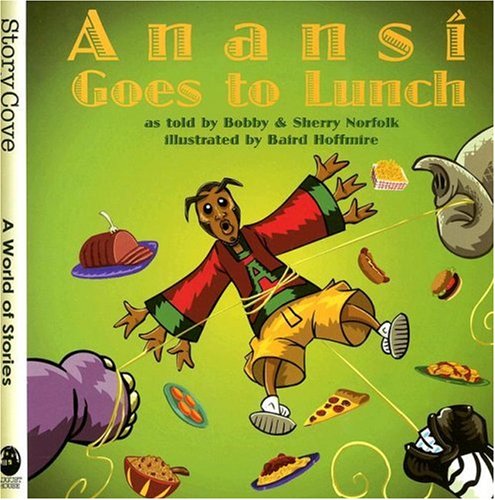Anansi Goes to Lunch (Story Cove: a World of Stories)

|
Author:
Bobby Norfolk
Price:
$ 1.46 (new)
$ 1.82 (used)
Medium:
Paperback (32 pages)
Publisher:
August House
2007-09-25 |
Editorial Description
Anansi is invited to three concurrent parties and wants to attend them all. He gives each of his hosts a rope to tug, ties the other end around his own waist, and waits to be summoned when the food is served -- but when all of the food is ready at the same time, Anansi is caught in the middle! That's why Spiders have small waists today.
Reader Reviews
Where is Anansi
The elementary school reading series in my district features two Anansi stories: "Anansi and the Talking Melon" and "Ananse's Feast." Both of them, in the retelling and in the illustrations, communicate a strong impression of Africa. I ordered a number of Anansi books to let my students compare and contrast different tales but in this retelling of "Anansi Goes to Lunch" the eponymous spider is now a sort-of African with three hands coming out of each sleeve of his jacket and two feet in track shoes. The meals that Anansi is invited to feature hamburgers, pizza, and apple pie. Along with other Anansi books in the "Story Cove" series it is hard to explain to my students why these are classically African folk tales when there is so little flavor of Africa in them.
 Silly, but Funny...
Silly, but Funny...
Although this story has roots in African folklore, it does seem somewhat "Americanized" in the presentation, but perhaps, that was the authors' intent--to appeal to children's sense of fun with familiar items (like pizza, hot dogs, hamburgers, spaghetti) while introducing a beloved character from another culture, the trickster spider, Anansi.
In this tale, Anansi looks more human than spider--even though he has six arms! Some readers may not like this particular rendering of the character. [For them, I suggest the Anansi stories as retold by Eric Kimmel and illustrated by Janet Stevens, which are among my favorite versions of the spider stories. In those versions, Anansi totally looks like a black spider, even though he is very human in actions and adventures.] My three-year-old nephew, though, loves the illustrations in "Anansi Goes to Lunch" because he is learning to count, and he delights in counting Anansi's six arms--three in each sleeve! My nephew's theory on the arms (despite the fact the Anansi is supposed to be a spider) is that the character needs all those arms to hold all the food he wants to take at the lunch parties. :) LOL
Cultural studies aside, the book still has some educational value in presenting concepts such as greed, personal responsibility, and decision-making (especially when choosing among many great choices). It's worth reading and discussing. It's a great "read-aloud" book for beginning readers. Our family enjoys Story Cove books and their companion websites, so we rate this tale very high.
**Older readers and students might enjoy comparing / contrasting this book with other versions of the Anansi tales. Such activities can help to develop critical thinking, interpretation, and observation.
Some other interesting renderings of the Anansi tales are...
The Pot of Wisdom by Adwoa Badoe & Baba Wague Diakite [Stories contain a humanish looking spider, but his clothes look very African.]
Anansi Does the Impossible by Verna Aardema [This is a clever little tale, worth reading!]
Anansi The Spider: A Tale from the Ashanti by Gerald McDermott [This is a very unusual looking book! ]

 Silly, but Funny...
Silly, but Funny...